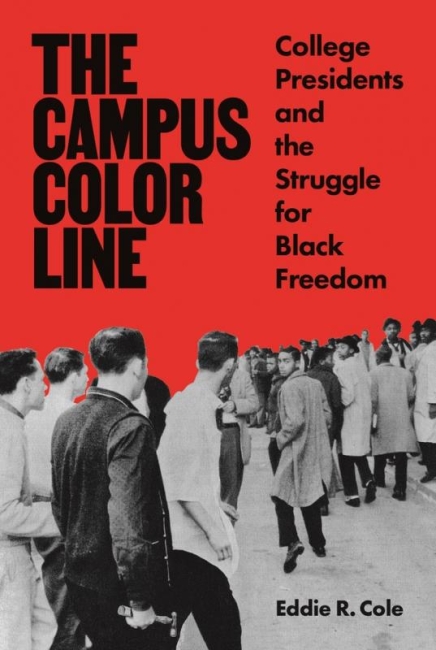You have /5 articles left.
Sign up for a free account or log in.

Courtesy of Princeton University Press
As college presidents across the country are called to address the institutional racism built into their campuses, many frame racial issues as a one-time concern, said Eddie R. Cole, an associate professor of higher education and organizational change at the University of California, Los Angeles.
This is a problem, because “no college campus is immune to social history,” Cole said. In his new book, out at the end of this month, The Campus Color Line: College Presidents and the Struggle for Black Freedom, Cole dives deep into college presidents’ historical role in desegregation, racist housing policies, free speech policies, affirmative action and more.
He traveled from North Carolina to Georgia, from Nashville, Tenn., to Syracuse, N.Y., and from Madison, Wis., to Austin, Tex., and beyond, scouring college archives and interviewing historians to learn more about college presidents’ role in shaping race and higher education policies in the years following World War II.
The Campus Color Line will be released Sept. 29.
Cole spoke with Inside Higher Ed about how he came to write the book and how the topics it touches on are still relevant today.
The following interview has been edited for length and clarity.
Q: Where did you get the idea to write this book?
A: The idea largely pulls from my own childhood growing up in Alabama. In rural west Alabama, in a county in the Black Belt region, the public school system I attended had 100 percent Black students, but there was also a nearby private academy that was predominately white. So I’ve always had in the back of my mind these questions about educational leaders and the decisions made around racial segregation, but also -- who were the decision makers like college presidents leading the way in these racial policies and practices that we have in society?
The writing process for this book was fairly interesting because I started quite narrow. I started looking at North Carolina in the 1960s because … the dominant narrative around student activism and college presidents -- particularly the lunch counter sit-ins -- starts with Greensboro. But despite that prevailing public narrative, historians have long demonstrated how the Black freedom movement, including Black student activism, started well before 1960. Therefore, it was critical that I also branch out. That is how my book became national in scope -- because there are no regional boundaries and there are no institutional-type restrictions to college presidents struggling with the issues of race on college campuses.
Q: In one chapter, you focus on free speech on campus. How should colleges be crafting free speech policies and responding to controversial speakers?
A: What I've found is it is just as important to monitor speech on campus as it is to monitor what the university does in response to a speaker coming to campus. And that's what history, through my research, has demonstrated time and time again. The most effective way to truly minimize the damage that can be caused by a controversial speaker is to actually implement operational changes to how the university functions in response to a controversial racist speech or hate speech.
You actually have to have the actions behind that public statement that condemns the controversial speaker and you have to implement policies that say, "We don't believe in anti-Black racism on this campus. And here are numerous initiatives that show that we are working to combat anti-Black racism on campus." That's what's absolutely critical for college presidents today, to not only be thoughtful about what speakers come to campus, but also be thoughtful about how we can create a campus atmosphere where a racist speaker doesn’t even want to come to this campus.
Q: Your book also looks at colleges’ role in housing discrimination and gentrification. Can you provide a bite-size explanation of this role?
A: As we think about college campuses expanding and gentrification near college campuses that are pushing out longtime residents, especially in predominantly Black areas, we have to think about the history and the role that college presidents have played in that issue. Following World War II, it’s a matter of housing discrimination nationally, particularly in major cities where neighborhoods were having overcrowding. University presidents actually gathered together … to influence federal housing policy. And during these testimonies before Congress and lobbyists' conversations, even meetings in the White House with former U.S. president Dwight Eisenhower, college presidents were central voices in shaping housing policy and getting urban renewal funds that ultimately displace Black communities throughout America.
We often talk about institutions on the macro level -- that the University of Chicago has a tense relationship with the South Side of Chicago, or the University of Pennsylvania has a contentious relationship with West Philadelphia. But at the end of the day, there were individuals leading these institutions who made intentional decisions that led to those contentious relationships. It's important for us to remember that historically and today, the relationship between campus and community very much comes down to the need for college presidents to look at their neighboring community as an equal partner in the educational enterprise, not just as an asset benefit only to the institution.
Q: What do you consider to be the most interesting topic that your book covers?
A: The history of affirmative action in higher education by far is one of the most interesting facts that we don't know enough about and certainly do not discuss enough. Today, when we think about affirmative action, the conversational talking points tend to lean exclusively on the admissions practices at a few highly selective, predominantly white universities. In reality, when affirmative action programs in higher education were being established, the [John F.] Kennedy administration made a broad call to college presidents across the nation -- this included historically Black colleges and the leaders of all-white or predominately white institutions. And together, both the presidents of Black colleges and white colleges actively created a number of programs that would help address racial issues in America. The majority of those programs were aimed at aiding historically Black colleges. But over a three-year period, the leaders of white institutions slowly dismantled those initial programs aimed at aiding Black colleges for the obviously supremacist-minded thinking that more-resourced white institutions were better served by these programs. Slowly, they adopted race-based admission practices that benefited the white institutions and left the programs initially designed to help the broader higher education system down to a select number of white institutions.
Q: If you rewrote the book today, would the issues that you focus on be the same?
A: The issues would be absolutely the same. If I had to start from scratch right now, today, I would focus on those same racial policies and practices. And we're talking about income disparities. We're talking about housing discrimination. We're talking about the challenge of equal educational opportunity. We're talking about public health issues. We're talking about police brutality. All of these are themes in the book that’s before you right now. And if I had to start over today, these are the same themes that we're discussing right now in this moment as we think about Black Lives Matter and other social movements trying to address racism in America. The issues remain the same.








